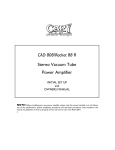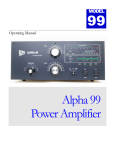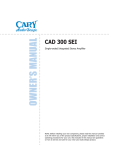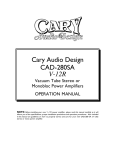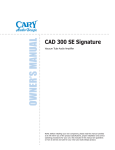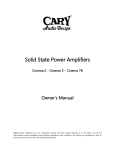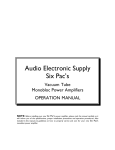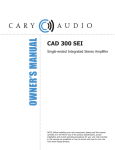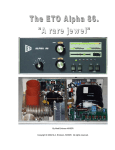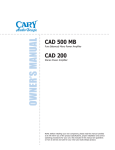Download Cary Audio Design Rocket 88R Specifications
Transcript
CAD 808/Rocket 88 R Stereo Vacuum Tube Power Amplifier INITIAL SET UP and OWNERS MANUAL NOTE: Before installing your new power amplifier, please read this manual carefully as it will inform you of the specifications, proper installation procedures and operation procedures. Also included in this manual are guidelines on how to properly service and care for your new Rocket 88 R. 1 IMPORTANT SAFETY INSTRUCTIONS WARNING: To reduce the risk of fire or electric shock, do not expose this appliance to rain or moisture. The lightning flash with arrowhead symbol within an equilateral triangle is intended to alert the user to the presence of un-insulated dangerous voltage within the product’s enclosure that may be of sufficient magnitude to constitute a risk of electric shock to persons. CAUTION: To reduce the risk of electric shock, do not remove the cover. There are no user serviceable parts inside. Please refer to qualified personnel for service. ALERT: The exclamation point within an equilateral triangle is intended to alert the user of the presence of important operating and maintenance (servicing) instructions in the literature accompanying the component. 1. READ ALL INSTRUCTIONS: All the safety and operating instructions of your Cary Audio equipment should be read before power is applied to the equipment. 2. RETAIN OWNER'S MANUAL: These safety and operating instructions should be retained for future reference. 3. HEED WARNING: All warnings on the unit and in the operating instructions should be adhered to. 4. FOLLOW INSTRUCTIONS: All operating and use instructions should be followed. 5. CLEANING: Unplug the unit from the wall outlet before cleaning. The unit should be cleaned only as recommended by the manufacturer. 6. ATTACHMENTS: Do not use attachments not recommended by the unit manufacturer as they may cause hazards. 7. WATER AND MOISTURE: Do not use the unit near water - for example, near a bath tub, wash bowl, kitchen sink, or laundry tub; in a wet basement; or near a swimming pool. 8. ACCESSORIES: Do not place the unit on an unstable cart, stand, tripod, bracket, or table. The unit may fall, causing serious injury to a child, an adult, or damage to the unit. Mounting of the unit should follow the manufacturer's instructions and should use a mounting accessory recommended by the manufacturer. 9. VENTILATION: Slots and openings in the cabinet are provided for ventilation to ensure reliable operation of the unit and to protect it from overheating. These openings must not be blocked or covered. The top or bottom panel openings should never be blocked by placing the unit on a bed, sofa, rug, or other similar surface. The unit should not be installed in a built-in location such as a bookcase or rack unless proper ventilation is provided. There should be free space of at least 6 inches (16cm) above the unit and an opening behind the unit. 10. GROUNDING OR POLARIZATION: The unit may be equipped with a polarized alternating current line plug (a plug having one blade wider than the other). This plug will fit into the power outlet only one way. This is a safety feature. If you cannot insert the plug fully into the outlet, try reversing the plug. If the plug should fail to fit, contact a licensed electrician to replace your obsolete outlet. Do not defeat the safety purpose of the polarized plug. 11. POWER SOURCES: The unit should be operated only from the type of power source indicated on the marking label. If you are not sure of the type of power supplied to your home, consult your unit dealer or local power company. 12. POWER CORD PROTECTION: Power supply cords should be routed so that they are unlikely to be walked on or pinched by items placed on or against them. Pay close attention to cords where they enter a plug, or a convenience receptacle, and the point where they exit from the unit. 13. OUTDOOR ANTENNA GROUNDING: If an outside antenna or cable system is connected to the unit, be sure the antenna or cable system is grounded so as to provide protection against voltage surges and built-up static charges. Article 810 of the National Electrical Code, NSI/NFPA 70, provides information regarding proper grounding of the mast and supporting structure, grounding of the lead-in wire to an Antenna-discharge unit, size of grounding conductors, location of antenna-discharge unit, connection to grounding electrodes, and requirements for the grounding electrode. IMPORTANT SAFETY INSTRUCTIONS 14. LIGHTNING: For added protection for the unit during a lightning storm, or when it is left unattended and unused for long periods of time, unplug it from the wall outlet and disconnect the antenna or cable system. This will prevent damage to the unit due to lightning and power line surges. 15. POWER LINES: An outside antenna system should not be located in the vicinity of overhead power lines or other electric light or power circuits, or where it can fall into such power lines or circuits. When installing an outside antenna system, take extreme care to keep from touching such power lines or circuits as contact with them might be fatal. 16. OVERLOADING: Do not overload wall outlets, extension cords, or integral convenience receptacles as this can result in a risk of fire or electric shock. 17. OBJECT AND LIQUID ENTRY: Never push objects of any kind into the unit through openings as they may touch dangerous voltage points or short-out parts that could result in a fire or electric shock. Never spill liquid of any kind on the unit. 18. SERVICING: Do not attempt to service the unit yourself as opening or removing covers may expose you to dangerous voltage or other hazards. Refer all servicing to qualified service personnel. 19. REPLACEMENT PARTS: When replacement parts are required, be sure the service technician has used replacement parts specified by the manufacturer or have the same characteristics as the original part. Unauthorized substitutions may result in fire, electric shock or other hazards. 20. SAFETY CHECK: Upon completion of any service or repairs to the unit, ask the service technician to perform safety checks to determine that the unit is in proper operating condition. 21. WALL OR CEILING MOUNTING: The unit should be mounted to a wall or ceiling only as recommended by the manufacturer. 22. HEAT: The unit should be situated away from heat sources such as radiators, heat registers, stoves, or other units (including amplifiers) that produce heat. 23. IMPORTANT SAFETY NOTE: Before connecting a new component such as the DVD 7 to your audio or home theater system it is always good practice to make certain that all components are turned off, and preferably unplugged from their AC power source. Many modern electronics products feature automatic turn-on circuits that may be activated during an installation, causing the potential for damage to electronic components and/or speakers. Such damage is not covered by product warranties and Cary Audio specifically disclaims responsibility for any such damage. Power Cord: The removable power cord that is shipped with the player is specifically designed to be used with this product. Other AC cords may be used, so consult your dealer for advice on AC power cords and high quality wire in your system. AC Fuse: The fuse is located inside the chassis and is not user serviceable. If power does not come on, contact your authorized service representative. Wiring: Cables that run inside of walls should have the appropriate markings to indicate compliance with, and listing by the UL, CSA or other standards required by the UL, CSA, NEC or your local building code. Questions about cables inside of walls should be referred to a qualified custom installer, or a licensed electrician or low-voltage contractor. Do Not Open the Cabinet: There are no user serviceable components inside this product. Opening the cabinet may present a shock hazard, and any modification to the product will void your warranty. If water or any metal object, such as a paper clip, coin, or staple accidentally falls inside the unit, disconnect it from the AC power source immediately and contact Cary Audio for further instructions. 24. RECORDING COPYRIGHT: Recording of copyrighted material for other than personal use is illegal without permission of the copyright holder. 25. NOTE TO CATV SYSTEM INSTALLER: This reminder is provided to call the CATV system installer's attention to article 820-40 of the NEC, ANSI/NFPA 70, which provides guidelines for proper grounding and, in particular, specifies that the cable ground shall be connected to the grounding system of the building, as close to the point of cable entry as practical. IMPORTANT SAFETY INSTRUCTIONS 26. FCC INFORMATION FOR USER: CAUTION: ANY changes or modifications not expressly approved by the party responsible for compliance could void the user's authority to operate the equipment. NOTE: This equipment has been tested and found to comply with the limits for a Class B digital device pursuant to Part 15 of the FCC Rules. These limits are designed to provide reasonable protection against harmful interference in a residential installation. This equipment generates and can radiate radio frequency energy and, if not installed and used in accordance with the instructions, may cause harmful interference to radio communications. However, there is no guarantee that interference will not occur in a particular installation. If this equipment does cause harmful interference to radio or television reception, which can be determined by turning the equipment off and on, the user is encouraged to try to correct the interference by one or more of the following measures: - Reorient or relocate the receiving antenna. - Increase the separation between the equipment and receiver. Connect the equipment into an outlet on a circuit different from where the receiver is connected. 27. OUTDOOR ANTENNA INSTALLATION/SAFE ANTENNA AND CABLE CONNECTION: If an outside antenna or cable system is connected to the equipment, be sure the antenna or cable system is grounded so as to provide protection against built up static charges and voltage surges, Section 810 of the national Electrical Code, ANSI/NFP A70 (in Canada, part 1 of the Canadian Electrical Code) provides information with respect to proper grounding of the mast and supporting structure, grounding of the lead-in wire to an antenna discharge unit, size of grounding conductors, location of antenna discharge unit, connection to grounding electrodes and requirements for the grounding electrode. Keep Antenna Clear of High Voltage Power Lines or Circuits An outside antenna system should be located well away from power lines, electric light or power circuits and where it will never come into contact with these power sources if it should happen to fall. When installing an outside antenna, extreme care should be taken to avoid touching power lines, circuits or other power sources as this could be fatal. Because of the hazards involved, antenna installation should be left to a professional. Dear Audiophile Friend: I would like to take this opportunity to personally thank you for purchasing a Cary Audio Design Rocket 88 R stereo power amplifier. I have spent many, many hours designing and voicing this latest iteration of our very popular Rocket 88. In fact, I have had tremendous fun listening to the new Rocket 88 R during and after the design phase. There are several design projects that stand out to me in the recent past. The three design projects that immediately come to my mind are the new CAD-805 10th Anniversary Edition single ended triode mono bloc power amps, the new V12 R stereo power amp and now the new Rocket 88 R. Designing and releasing the new Rocket 88 R has been a real treat to me and I hope it is for you as well. It combines our superb Cary Audio Design sound and build quality at a surprisingly modest price. We believe it is a truly a ‘Best Buy’ stereo vacuum tube power amplifier! The basic premise I started with on the Rocket 88 R was to develop a truly linear, wide bandwidth, stereo vacuum tube power amplifier. Also, in direct response to Rocket 88 owner’s comments about input sensitivity we wanted to ‘harmonize’ the input sensitivity level of the amplifier to match other components used in an audio system. I was seeking an amplifier design that would precisely mimic the input signals up stream from the source signals while being more sensitive. In the design, the front end stage EL-84 tubes are used as current sources for the high gain 12BZ7 driver stage and phase inverter tubes, with one used for each channel. (12AX7 or 12AY7 tubes may be substituted for the 12BZ7.) The EL-84’s do not do any of the amplification. They allow the 12BZ7 phase inverters to operate in an equal balanced fashion. From the first incarnations of this project to the final result it was an intriguing concept, to say the least. We found that changing the input circuit to accept the ‘12 series’ vacuum tubes caused a dramatic drop in total harmonic distortion. Overall circuit dynamics and frequency bandwidth improved with the new driver tubes as well. We have come to the conclusion that the limiting factor in the previous Rocket 88 design was the 6922 tube we used in the front end stage. The ‘12 series’ tubes certainly fixed that! I realize you may think I am rambling but I am just so excited about the Rocket 88 R amplifier. Imagine listening to a compact stereo tube amplifier driving a pair of B &W 801 Nautilus 15” woofer loudspeakers to thunderous levels in both 30-watt Class A triode and 60-watt Class A/B ultra-linear pentode mode. Full speaker control with complete coverage of the frequency extremes is the result of the changes. I just can’t imagine it any better. Please read the complete operating manual before turning on your amplifier and get ready for the musical time of your life. Thank you once again for your interest and continued support for Cary Audio Design. Dennis J. Had President Cary Audio Design THEORY OF OPERATION For the technically minded, a review of the circuit is in order. Your new Rocket 88 R operates in push pull triode Class A mode and in class A/B ultra-linear mode. The output stage KT-88 tubes are biased with a negative fixed bias voltage for low distortion and maximum output capabilities. In the triode mode, the Rocket 88 R is the most linear and yields the most musically satisfying presentation. The output power is 30 watts of triode power per channel and 60 watts per channel in ultra-linear mode. The output transformers on the Rocket 88 R are the most important component in the amplifier. They have been specifically designed by Cary Audio for use in the Rocket 88 R. We have taken the approach in the output transformer design not too dissimilar to the single-ended amplifiers we design and produce. The primary and secondary windings on portions of the output transformer are wound in a bifilar process with the two inductors interleaving sixteen times. The bifilar wind (two conductors wound at the same time) will yield the closest balance and coupling of any design currently utilized in vacuum tube output transformers. The E/I laminates used are silicone impregnated hipersil steel contributing to the extremely low loss of the Rocket 88 R output transformer. The above process is similar to the single-ended air-gap design found on the Cary single-ended output transformers. A balanced drive signal is applied to the control grids of the KT-88 output tubes from the 12BZ7 phase inverter/driver tube. This tube is configured in a dual differential network that operates in the following manner: The first section of the dual triode 12BZ7 tube is direct coupled to the input RCA or XLR jack on the rear apron of the amplifier. The drive signal is amplified through this first section in a class A, grid driven circuit with the output signal inverted 180 out of phase at the anode and then coupled to one half of the push-pull bank of KT-88’s. At the same time the second half of the dual triode 12BZ7 is cathode driven in a grounded grid non-inverting class A gain stage coupled to the other half of the push-pull bank of KT-88’s. With this network the balance is a perfect plus and minus dual drive signal to drive the final KT-88’s in a balanced push-pull configuration. The 12BZ7 cathodes are direct coupled to the anode (sit on top) of the EL-84 in an infinite current source configuration. The EL-84 stage takes the place of the conventional dropping resistor network found in conventional gain stages. The power supply transformer is designed to operate at 200% continuous commercial service at the full rated 80 watt output level. The high voltage power supply section is a full wave center tap configuration (not some cheap voltage doubler as used in many competitor’s amps) to a dual PI network with two filter chokes. This high voltage section feeds the final output KT-88 tubes. An additional choke, filter network serves as the power supply for the 12BZ7 phase inverter tubes. Another supply is the negative DC grid bias and current source voltage for the EL-84’s. A great deal of attention during design of your new Rocket 88 R was concentrated on the “overload recovery” ability of the amplifier. The ability of an amplifier to instantly recover from clipping is much more important than is commonly believed. In the output power war of some amplifier manufacturers, the mentality is focused on high and then even higher overall power output levels to try to solve the clipping problem. In reality, we believe the most critical aspect is how fast a recovery an amplifier can achieve after overload. With the incredible dynamics range of live and recorded music, even 2,000 watts of power is potentially not enough. Most of the music being listened to in an average home listening room is only requiring about 1-3 watts of power. It is on the transients of loud low frequency program material that tremendous signal voltages will appear at the input of the amplifier. It is in this situation that the overload recovery ability of an amplifier is of critical concern. The Rocket 88 R extols its merits in the ability to handle transients and instantaneously recover from brief or even extended overloads. The Rocket 88 R will overload symmetrically at any frequency in the audio bandpass. It will also yield faithful reproduction of extremely low frequencies at full output levels. The power transformer, the power supply regulation and the output transformer design and careful shaping of the overall frequency response curve all play a very important part in the ability of the Rocket 88 R to recover quickly when overloaded. If one were to monitor the high voltage rail voltage of the Rocket 88 R during soft and also loud music passages it would be found there is no more than a volt or so change from soft to loud passages. Another technical feature of your new Rocket 88 R amplifier is unconditional circuit stability. The Rocket 88 R maybe operated with no load (without speaker) without damage to the amplifier, output transformer or tubes. Operating the Rocket 88 R stereo amplifier is a simple procedure since each unit is designed for long term stability in virtually any home operating situation. Therefore, if the unit is operated outside the parameters outlined in this owner’s manual, damage may result. Please read this manual carefully before putting your new Rocket 88 R amplifier in operation. The following definitions are applicable to this manual. These definitions must be followed explicitly. WARNING! HAZARD PRESENTS PERSONAL INJURY OR DEATH Caution EQUIPMENT DAMAGE MAY OCCUR BUT NOT PERSONAL INJURY Note Proper performance of the amplifier cannot be ensured if disregarded Specifications: Rocket 88 R Stereo Power Amplifier DIMENSIONS: 10”W x 18”D x 6”H (25.4 cm x 45.7 cm x 15.2 cm) WEIGHT: 45 Lb.. (20.4 kg) CIRCUIT TYPE: Push-Pull Triode Class A, Ultra-linear Class A/B POWER OUTPUT: 30 Watts Triode, 60 Watts Ultra-linear INPUT SENSITIVITY: 1.2 volt for full output INPUT IMPEDANCE: 150,000 ohms NOISE AND HUM: -87 dB below rated output FREQUENCY RESPONSE: 10 Hz to 82,000 Hz + 0, -3.0 dB @ 1 watt TUBES: 2-12BZ7 Dual Triode, Phase inverter, gain stage (12AX7, 12AY7) 2-EL-84 Current source (or 6BQ5) 4-KT-88 Output tubes (or EL-34, 6550, KT-66, KT-77, KT-90) 2-1629 Green ‘Cat Eye’ indicator tubes TRANSFORMERS: 1-EI laminated core power transformer 2-Special interleaved output transformer 3-Filter Chokes 200% duty cycle on all transformers RESISTORS: 1.0 % metal film CAPACITORS: Polystyrene and polypropylene (oil filled optional) POWER SUPPLY CAPACITORS: AC CORD: AC POWER REQUIREMENTS: WARM-UP TIME: BREAK-IN PERIOD: FINISH: 2-560 μFD @ 450 VDC 3-10 μFD Film and foil @ 600 VDC 1-47 μFD @ 450 VDC Detachable 3 conductor 14 gauge 117 volts or 240 volts AC 50/60 Hz 300 watts operate 3 minutes 100 hours of music playing time Black Epoxy powder coat, Anodized Aluminum face plate Specifications are subject to change or improvement without notice or obligation. Front Panel Features AC-ON ROTARY SWITCH: Turns AC power on in the “on” position. GREEN ‘CAT EYES’: Indicate audio power output, fully closed eye at maximum power. Rear Apron Features INPUT: Signal input connection via either RCA or XLR shielded interconnect cables. Pin #1 is the shield, #2 positive phase signal on XLR connector. INPUT SWITCH: Push in direction of the type of input to be utilized, RCA or XLR. OUTPUT: The 5-way speaker binding posts provide the output to the speaker system. Red posts = positive connections, Black posts = negative connections. AC: 3 conductor detachable power cord AC POWER FUSE: Use only a 3 Amp, 250 V ‘slow blow’ fuse. Rocket 88 R Top Panel BIAS LED: These indicators will light when there is the proper bias voltage operating for the EL-84 current source tubes along with the proper DC grid bias voltage for the final output tubes. If these LED’s fail to light, discontinue use and place a call to the Cary Audio service advisor. TRIODE/UL SWITCH: These switches change the operation of the Rocket 88 R between triode, class A, to Ultra-Linear, class A/B. These two switches maybe switched during operation. If one channel switch is in the opposite position from the other a channel imbalance will occur. There is 1 dB more gain in the Ultra-Linear position. BIAS: This screw driver adjustment is used to set the proper DC bias current for the KT-88 output tubes. REMEMBER, THIS ADJUSTMENT MUST BE ADJUSTED WITH A METER READING DC mA CURRENT! TUBE FUSE: This is a ‘fast blow’ ½ amp fuse to protect the Rocket 88 R amplifier should an output tube fail. CAUTION USE OF ANY OTHER PROTECTION FUSE CAN DAMAGE UNIT BIAS JACK: This ¼” two conductor jack is used to plug in the supplied meter cable. This is a shorting jack. In other words, when the plug is removed the circuit is automatically connected. You may plug in the test plug while the unit is playing. You may hear a slight click in the loudspeakers when inserting or removing the plug. This is normal. SPEAKER: These switches change the 4 and 8 ohm output taps from the output transformer to the speaker posts on the rear of the amplifier. They maybe operated with the amplifier in operation. EYE TUBE: There are two of these. They set the green eye tube intensity. You may set to any desired level for your listening room. The control does not change any of the sonic characteristics of the amplifier. INSTALLATION This section describes the unpacking and installation procedures for the Rocket 88 R amplifier. WARNING! MAKE NO ATTEMPT TO PUT THE AMPLIFIER IN SERVICE WITHOUT THE BOTTOM PLATE ATTACHED-CONTACT WITH VOLTAGE INSIDE THE CHASSIS OF THE ROCKET 88 R CAN BE FATAL! Unpacking All shipping containers have been specifically designed to protect their contents and special care has been taken to prevent damage under normal shipping conditions. Mishandling should be evident upon inspection of the shipping container. If damage is found after visual inspection, take care not to destroy the evidence. If necessary, document the damage with photographs and contact the transport carrier immediately. Carefully remove your new Rocket 88 R amplifier from its packing carton, and examine it closely for signs of shipping damage. It is recommended to save all original packing cartons to protect your amplifier from damage should you wish to store it or ship it for after sales service. Warranty Card Fill out the enclosed warranty registration card and return it to Cary Audio Design within 10 days of original purchase. Keep your original sales slip with the packing cartons should you ever need it for reference. Failure to register warranty will limit the warranty to one year. Amplifier Placement and Set Up In general, the location of your new Rocket 88 R amplifier is not critical. The best placement in your system is near the speaker system with short lengths of speaker cables. Certain precautions must be taken to ensure optimum performance. Avoid hot locations near radiators or other heating units. Keep the top of the Rocket 88 R clear of books, paper, or other equipment to protect against overheating. Power Requirements The Rocket 88 R is designed to operate from house current mains. The design voltage is 117 VAC at 50/60 Hz. (Export models are 117 or 240 VAC at 50/60 Hz, depending on destination.) Cables The speaker cables to the speakers can be any convenient length your setup requires. Please choose speaker cables of sufficient size to preserve the outstanding performance capabilities of your Rocket 88 R. Heavy gauge #14 AWG wire is suitable for distances up to 10 feet; #12 AWG for 25 feet. Our recommendation for best sound is to place the Rocket 88 R in between the stereo pair of loudspeakers. Use heavy duty loudspeaker cables with a length to reach from the Rocket 88 R to the speakers. Avoid long lengths that have excess slack. If your loudspeaker has the facility for bi-wiring, then by all means use separate cables or bi-wire speaker cables. Your Authorized Cary Audio Design Dealer will have proper speaker cable in stock for this purpose. Signal input connection is made via the input jacks on the rear of the amplifier located next to the output binding posts. The interconnect cables from the output of the preamplifier can be any convenient length your setup requires. Through the years we have found that using tube amplifiers like the Rocket 88 R, it is better to have short loudspeaker cables and long interconnect cables to the preamplifier. The choice of a high quality shielded interconnect cable is important. Once again, your dealer will have the proper cables in stock for this purpose. The tubes used in your new Rocket 88 R have gone through a 48 hour burn in process and testing with your individual Rocket 88 R. They are matched and labeled on the tube boxes. Look at the top panel of the Rocket 88 R for the proper placement of the tubes. Be careful to insert the tubes in the proper sockets with the key way in order. At the end of this manual you will also see a block diagram of the tube layout. Your new Rocket 88 R is ready for operation after the speaker, interconnect cables and the vacuum tubes have been installed. AC Power Switch Simply turn the AC power to the ON position (the red bias LED’s will light). After 30 to 60 seconds observe that all tubes are lit (filaments) and the green eye tubes are illuminated. Should you not observe the above conditions, turn off the amplifier and check the power cord and AC socket. Triode/Ultra-Linear Switch On the top of the chassis behind the KT-88 output tubes is located a chrome handle switch. With the handle pushed to the rear of the amplifier the mode of operation is ultra-linear. In the forward position the mode will be in triode class A mode. This set of switches maybe switched during listening. A slight click maybe heard in the loudspeakers. This is normal. Usually the triode position will provide plenty of power and is the most preferred position by most audiophiles and the designer of the Rocket 88 R. Bias Setting Your new Rocket 88 R bias adjustment has been factory set prior to shipping. Please keep in mind that the bias will vary from location to location depending on the AC line voltage. The design of the Rocket 88 R is such that you may start listening with the factory set level. DO NOT TURN THE BIAS ADJUSTMENT SCREW WITHOUT WATCHING LEVELS ON A DC mA CURRENT METER! The type of meter used must be a DC current meter or a volt ohm meter with a DC milliampere current scale. A digital multi-meter is very inexpensive and available at a local Radio Shack or ACE hardware store. Included with your shipment of the Rocket 88 R is a black and orange patch cord with a ¼” male plug and two clips. This is the bias adjustment cable. To check and/or set the bias simply place the red clip lead on the positive meter lead. The black clip lead will hook up to the black negative lead of the test meter. The meter must be placed in the DC current mode. If the meter has a selectable scale use the one that measures 0 to 300 ma DC current. With the Rocket 88 R turned on and operating for about 10 minutes you will have the resting current level indicated. This measurement should be done without any music playing. A nominal level of 200 milliampere (mA) is standard for the Rocket 88 R. If the level is lower, advance the bias adjustment to the clockwise direction. Higher readings, turn the bias control to the left, counterclockwise direction. After you have established a 200 mA reading simply pull out the plug from the bias jack. You may hear a slight click in the speaker. This is normal. Bias levels will change with time of day and power usage in your home. In fact during the summer months when the air conditioner is running you may have less AC line voltage available and in turn the bias will be slightly lower. This is not critical. In fact the Rocket 88 R is designed to operate in the range of 180 to as high as 240 mA DC current. The best sound will generally be produced in the 195 to 225 mA region. You may wish to experiment if you desire. NEVER ADJUST THE BIAS SETTING WITH A VOLTMETER SET TO THE VOLTAGE POSITION! Break In Period The tubes, capacitors and output transformers take approximately 100 hours of music playing to fully settle in for peak performance. The Rocket 88 R will sound good fresh out of the box. However, after the first couple of hours you will notice increased depth and tighter bass. This break in period is normal for tube based components and with high performance audio components. SERVICE AND CARE WARNING! MAKE SURE AMPLIFIER IS UNPLUGGED FROM AC MAINS Care and Cleaning The chassis of the Rocket 88 R may be cleaned with a soft rag and Windex (or a similar window cleaner). A dry feather duster is also good for cleaning the chassis. Tube Replacement If it becomes necessary to replace the tubes in the Rocket 88 R amplifier, a matched set of tubes of the same brand should be used. A new tube kit is available from your Cary Audio dealer. You should get 2-5 year’s from the output tubes and even more years of use from the 12BZ7 and EL-84 tubes with everyday usage. Factory Service Careful consideration has been given to the design of your Rocket 88 R amplifier to keep maintenance problems to a minimum. However, it is possible that some problems may arise which cannot be cured by tube substitution. At this point we suggest that you contact our Customer Service Department from 1 to 5 PM East Coast Time, phone number 1-919-355-0010, to describe your problem in detail. Do not return the amplifier to the factory without a return authorization number from the Customer Service Department. Cary Audio Design will assume no responsibility if the transportation company refuses to pay a damage claim due to improper packing or lack of insurance should the unit be lost in shipment. Cary Audio Design 1020 Goodworth Drive Apex, North Carolina 27539 www.caryaudio.com [email protected] Tel: 919-355-0010 Fax: 919-355-0013 WARNINGS! MAKE NO ATTEMPT TO PUT THE ROCKET 88 R INTO SERVICE OUTSIDE OF THE CABINET. CONTACT WITH THE HIGH VOLTAGES FOUND INSIDE THE UNIT CHASSIS CAN BE FATAL! COMPLETELY REMOVE THE AC POWER PLUG FROM THE WALL AND ALLOW 30 MINUTES FOR THE HIGH VOLTAGE CAPACITORS TO DISCHARGE THROUGH THE BLEEDER RESISTORS BEFORE YOU ATTEMPT TO CHANGE THE TUBES OR TO CLEAN THE INSIDE OF THE AMPLIFIER! CAUTIONS NEVER REMOVE or INSERT AC PLUG WHEN THE UNIT IS ON OR THE AC POWER SWITCH IS IN THE “ON” POSITION. OBSTRUCTION OF THE TOP PORTION OF THE ROCKET 88 R WILL RESULT IN THE TUBES OVERHEATING. *PLEASE OBSERVE ALL THE SAFETY DIRECTIONS IN THIS OWNER’S MANUAL TO AVOID RISK OF PHYSICAL HARM!* UNITED STATES LIMITED WARRANTY Cary Audio Design warrants to the original United States purchaser for use in the United States that Cary Audio Design vacuum tube or solid state power amplifiers, surround sound processors or preamplifiers shall be free from defects in parts or workmanship for three (3) years from the date of the original purchase. Vacuum tubes, if any are used in the component, are offered a 90 day from purchase date exchange policy against defects with the exception of the CAVT 300B vacuum tube which has a (1) one year from purchase date exchange policy. Any digital drive design, whether a Cary Audio Design CD or SACD player or a Cary Cinema DVD player, has a limited one year parts and labor warranty against defects in manufacture. This is a limited warrant, for the original purchaser only and does not transfer to any subsequent owner. During the limited warranty period, Cary Audio Design or an authorized Cary Audio Design service facility will provide free of charge both parts and labor necessary to correct any defects in material or workmanship. To obtain such warranty service, the original purchaser must: 1. Complete and send in the warranty Registration Card within 15 days of purchase. 2. If claiming service the owner must send a fully filled in copy of the original sales receipt along with any unit sent in for service showing the AUTHORIZED CARY AUDIO DESIGN DEALER’S name, the new selling price, the buyer’s name, e-mail or phone number and address on the receipt. Blank receipts will NOT validate the limited warranty for service. 3. Notify Cary Audio Design as soon as possible after the discovery of a possible defect and submit the following information to determine eligibility for warranty: (a) The model number and serial number; (b) A fully filled in copy of the original sales receipt showing the original selling price, purchasers name and address filled in by an AUTHORIZED CARY AUDIO DESIGN DEALER with the original date of purchase shown on the form; (c) a detailed description of the problem. 4. Deliver the product to Cary Audio Design or the nearest authorized service facility or ship with all freight and insurance charges prepaid, in its original packing container or equivalent, to Cary Audio. Correct maintenance, repair and use are important to obtain performance from this product. Therefore, please carefully read the Operating Manual. This warranty does not apply to any defect that Cary Audio Design in its sole discretion determines is due to: 1. Improper maintenance or repair, including the installation of parts or accessories that do not conform to the quality and the specifications of the original parts. 2. Misuse, abuse, neglect or improper installation. 3. Accidental or incidental damage. WARRANTY DISCLAIMER Except for the express warranties stated herein, Cary Audio Design disclaims all other warranties including, without limitation, all implied warranties of merchantability and fitness for a particular purpose. The foregoing constitutes Cary Audio Design’s entire obligation with respect to this product, and the original purchaser and any user or owner shall have no other claim for incidental or consequential damages. Some states do not allow the exclusion or limitation of incidental or consequential damages, so the above limitation and exclusion may not apply to you. This warranty gives legal rights and you may also have other rights, which vary from state to state. EXCLUSIVE REMEDY Notwithstanding the foregoing, the purchaser’s exclusive remedy for any breach of warranty, express or implied, is limited to the repair or replacement of the defective unit or the refund of the purchase price, at the option of Cary Audio Design. Under no circumstances is Cary Audio Design liable for incidental or consequential damages. Any implied warranties imposed by law terminate one (1) year from the date of purchase. INTERNATIONAL PURCHASERS (Export markets) Cary Audio Design warrants its merchandise to purchasers within the United States exclusively for use within the United States of America. It provides no other warranties, expressed or implied. If you are living outside the USA, please consult with your local dealer or distributor to determine the details of your local warranty.















